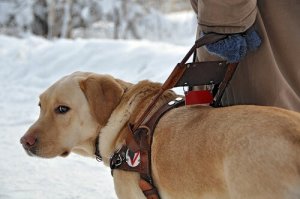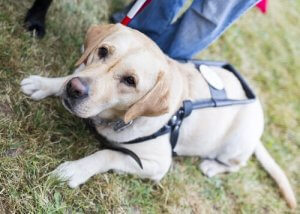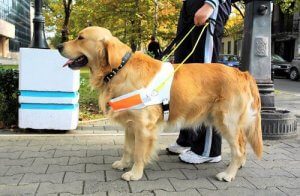Everything You Need to Know About Guide Dogs


Written and verified by the lawyer Francisco María García
Any dog is capable of learning and showing affection. But some go way farther than simply learning to sit on command, or fetching their owner’s slippers. Guide dogs are a great example of what can be achieved when you combine natural canine intelligence with expert professional training.
Human history can tell us a lot about how the relationship between man and dog has developed and evolved. Over time, they have transformed from being hunting partners to beloved pets. Their great loyalty and ability to learn has more than earned them their title of man’s best friend.
Training techniques have also evolved, allowing humans to use dogs’ loyalty and keen senses to improve the lives of people around the world. Guide dogs are one of the best examples of this.
What are guide dogs?
Guide dogs (aka. service dogs or assist dogs) perform an important social function. Their work helps prevent people with disabilities from becoming socially isolated and marginalized.

Guide dogs play a vital role in their owners’ lives. They allow them to carry out everyday tasks more easily, giving them back their independence and improving their overall quality of life. They play a particularly special role in the lives of the visually impaired.
The origins of the guide dog
Originally aimed at helping First World War veterans, the first modern guide dogs were trained back in the 20s and 30s. The first four guide dogs to arrive in Great Britain were a present for former soldiers who sustained partial or total vision loss during the war. It was the British government who covered the training costs, just as they do today.
Back then, sheepdogs and German shepherds were the most popular choice for guide dogs. Their great intelligence and physical endurance meant that these dogs were already widely used in military operations. Trainers commonly chose female dogs over males, due to their willingness to share territory, and their great loyalty to their owners.
Today, however, the Labrador Retriever is the guide dog of choice. As intelligent and capable as the German Shepherd, but with a calmer, more relaxed temperament, they are perfectly suited to this work. Their friendly demeanor and appearance also mean that people are less intimidated by Labradors than other dogs.
In many countries, it is usually either the state or charitable organizations that cover training costs. Funding for guide dog training often forms an important part of social inclusion projects. In the US, guide dogs must be trained and certified by the ADA.
How to train a guide dog
As you probably already know, Labradors can be rather boisterous if not trained properly. Their great intelligence and boundless energy means they have bags of potential and a huge capacity for learning. It’s simply a question of channeling this energy into something productive.
Today, Labradors work in a number of important roles. As well as working as guide dogs, they are also used for bomb and drug detection, physical and psychological therapy, and continue to be one of the most popular family pets.
Their physical and behavioral characteristics make them the perfect guide dogs. Roughly 21 inches in height, they are highly intelligent, sociable and curious animals, with great physical endurance.
Experts usually select guide dogs when they’re still only puppies, so that they can begin their training as early as possible. The majority of professional guide dog training schools have their own breeding programs.
Guide dogs: puppy training
To temper some of their immense energy, experts recommend castrating Labradors at a young age. In the case of females, this should be just before their first heat.
From the age of 4 weeks old, trainers perform a number of tests to track behavioral patterns. The puppies are exposed to a number of different stimuli, from new sounds and environments, to different weather conditions. They also learn to walk on a leash, sit, and fetch different objects on command.
From around three months old, trainers observe their reactions to moving vehicles, changes in surfaces, hanging objects, obstructions, and passing pedestrians. Guide dogs need to be able to recognize changes in their environment, and change course when they encounter any kind of obstacle.
Guide dog school
At 12 months of age, the puppy will officially start guide dog school, where it will begin its training in earnest.

The first stage of training lasts around 4 months. The dog learns to obey and disobey commands by following predetermined instructions. To begin with, trainers will use a leather harness, which has a metal handle attached to rings on either side. It is through this handle that owners communicate with their dogs. The harness allows each to feel the other’s movements.
Once it has learned to walk on the harness, the dog will learn to stop when it reaches a set of stairs or a steep slope. This helps prevent accidents. They also learn how to navigate corners, learning how to turn to the left and right.
The next step involves teaching the dog when to disobey commands, in order to avoid accidents and confusion. The dog will also learn how to avoid hanging objects, check for traffic before stepping off the sidewalk, navigate and measure the distance between obstacles, step back up onto the sidewalk and continue their journey.
Finally, the guide dog will learn how to get on public transport and find a suitable place for its owner to sit.
All this is just a small part of a guide dog’s training. By the end, they will be able to help their owners with a huge variety of everyday tasks, hugely increasing their independence, and their quality of life as a whole.
Any dog is capable of learning and showing affection. But some go way farther than simply learning to sit on command, or fetching their owner’s slippers. Guide dogs are a great example of what can be achieved when you combine natural canine intelligence with expert professional training.
Human history can tell us a lot about how the relationship between man and dog has developed and evolved. Over time, they have transformed from being hunting partners to beloved pets. Their great loyalty and ability to learn has more than earned them their title of man’s best friend.
Training techniques have also evolved, allowing humans to use dogs’ loyalty and keen senses to improve the lives of people around the world. Guide dogs are one of the best examples of this.
What are guide dogs?
Guide dogs (aka. service dogs or assist dogs) perform an important social function. Their work helps prevent people with disabilities from becoming socially isolated and marginalized.

Guide dogs play a vital role in their owners’ lives. They allow them to carry out everyday tasks more easily, giving them back their independence and improving their overall quality of life. They play a particularly special role in the lives of the visually impaired.
The origins of the guide dog
Originally aimed at helping First World War veterans, the first modern guide dogs were trained back in the 20s and 30s. The first four guide dogs to arrive in Great Britain were a present for former soldiers who sustained partial or total vision loss during the war. It was the British government who covered the training costs, just as they do today.
Back then, sheepdogs and German shepherds were the most popular choice for guide dogs. Their great intelligence and physical endurance meant that these dogs were already widely used in military operations. Trainers commonly chose female dogs over males, due to their willingness to share territory, and their great loyalty to their owners.
Today, however, the Labrador Retriever is the guide dog of choice. As intelligent and capable as the German Shepherd, but with a calmer, more relaxed temperament, they are perfectly suited to this work. Their friendly demeanor and appearance also mean that people are less intimidated by Labradors than other dogs.
In many countries, it is usually either the state or charitable organizations that cover training costs. Funding for guide dog training often forms an important part of social inclusion projects. In the US, guide dogs must be trained and certified by the ADA.
How to train a guide dog
As you probably already know, Labradors can be rather boisterous if not trained properly. Their great intelligence and boundless energy means they have bags of potential and a huge capacity for learning. It’s simply a question of channeling this energy into something productive.
Today, Labradors work in a number of important roles. As well as working as guide dogs, they are also used for bomb and drug detection, physical and psychological therapy, and continue to be one of the most popular family pets.
Their physical and behavioral characteristics make them the perfect guide dogs. Roughly 21 inches in height, they are highly intelligent, sociable and curious animals, with great physical endurance.
Experts usually select guide dogs when they’re still only puppies, so that they can begin their training as early as possible. The majority of professional guide dog training schools have their own breeding programs.
Guide dogs: puppy training
To temper some of their immense energy, experts recommend castrating Labradors at a young age. In the case of females, this should be just before their first heat.
From the age of 4 weeks old, trainers perform a number of tests to track behavioral patterns. The puppies are exposed to a number of different stimuli, from new sounds and environments, to different weather conditions. They also learn to walk on a leash, sit, and fetch different objects on command.
From around three months old, trainers observe their reactions to moving vehicles, changes in surfaces, hanging objects, obstructions, and passing pedestrians. Guide dogs need to be able to recognize changes in their environment, and change course when they encounter any kind of obstacle.
Guide dog school
At 12 months of age, the puppy will officially start guide dog school, where it will begin its training in earnest.

The first stage of training lasts around 4 months. The dog learns to obey and disobey commands by following predetermined instructions. To begin with, trainers will use a leather harness, which has a metal handle attached to rings on either side. It is through this handle that owners communicate with their dogs. The harness allows each to feel the other’s movements.
Once it has learned to walk on the harness, the dog will learn to stop when it reaches a set of stairs or a steep slope. This helps prevent accidents. They also learn how to navigate corners, learning how to turn to the left and right.
The next step involves teaching the dog when to disobey commands, in order to avoid accidents and confusion. The dog will also learn how to avoid hanging objects, check for traffic before stepping off the sidewalk, navigate and measure the distance between obstacles, step back up onto the sidewalk and continue their journey.
Finally, the guide dog will learn how to get on public transport and find a suitable place for its owner to sit.
All this is just a small part of a guide dog’s training. By the end, they will be able to help their owners with a huge variety of everyday tasks, hugely increasing their independence, and their quality of life as a whole.
This text is provided for informational purposes only and does not replace consultation with a professional. If in doubt, consult your specialist.








